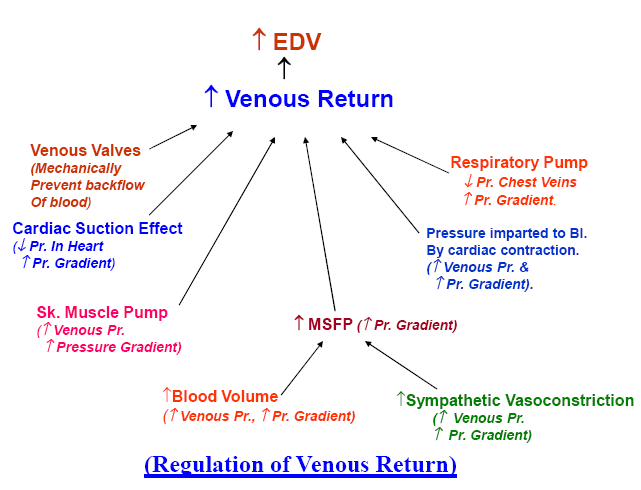Volume of blood flowing from veins into the right atrium each minute.
• Venous return is the sum of all the local blood flows from
individual segments of the peripheral circulation.
• Venous return at rest = 5 L/min
• Venous return (& its factors affecting) is the primary
controller of the cardiac output.
Factors affecting Venous Return:
1. Muscle pump & Unidirectional Venous valves.
2. Valve competence
3. Vascular tone — Venous tone
— Arteriolar tone
4. Respiration — Intrapleural pressure
5. Heart beat — Ejection Phase (apex to base Vent. Shortening)
— Vent. Diastole
6. Blood Volume
7. Rt. Atrial Pressure ( Rt. Atrial Pr. Venous Return)
8. Gravity, Posture
9. Intrapericardial Pressure/Effusion/Cardiac Temponade
10. Venous Obst.
11. Degree of filling of systemic circulation. (MSFP)
Regulation of Venous Return
Normally Atrial pressure is near zero and venous return
is promoted by the driving pressure gradient in low
resistance veins.
Venous Return is Facilitated by:
I. Driving pressure by the heart & Lungs:
I. Cardiac suction effects
II. Low Atrial pressure
III. Pressure imparted to blood by cardiac
contraction
IV. Respiratory/Thoracic Pump
II. Pressure Gradient between Veins and Heart
• Mean Systemic Filling Pressure(MSFP)
• Blood Volume
• Sympathetic
Vasoconstrictor Activity
• SK. Muscle Pump
• Venous Valves preventing backflow of
blood.
Driving Pressure Promoting Venous Return
1) Effect of Cardiac suction on Venous Return:
a. During Ventricular contraction:
Apex to base shortening, AV valves drawn downward so Atrial Pressure drops below zero which increases
Vein-to-Atrial Pr. gradient.
b. During Ventricular Relaxation:
Rapid expansion of Ventr. Chambers so
-ve Pr. in Ventricles ‘to suck the blood in’ from
atria & Veins which increases Vein-to-ventricle Pressure gradient.
“Thus Heart Functions as Suction Pump”.
2) Effect of Respiratory Activity on Venous Return:
–ve Intrapleural (intrathoracic) Pressure = -5 mmHg
(subatmospheric)
Facilitates Venous return by suction due to respiratory
pump.
More active during exercise (due to inceased Respiratory Activity)
Pressure Gradient between Veins and Heart:
Mean systemic filling Pressure: (MSFP)
Pressure measured everywhere in systemic circulation
when all flow of blood flow is stopped.
MSFP is the degree of filling of systemic circulation
MSFP forces the systemic blood towards the heart.
Normal MSFP = 7 mmHg.
As Rt. Atrial Pr. is subatmospheric (eg: -2 mmHg)
& MSFP is 7 mmHg; the MSFP provides the gradient for
venous return.
If, Rt. Atrial Pr. Rises (Heart failure, A-V valves disease);
the venous return will stop when Rt. atrial Pr. approaches
MSFP i-e 7 mmHg.
Blood Volume:
increased Blood Volume = Increased Venous Pressure & increased MSFP which leads to increased Pressure gradient.
Effect of Sympathetic Vasoconstrictor Activity:
Increased Venous tone leads to increased Venous Pressure (increased MSFP) approx. 17 mmHg
Leading to increased Pressure gradient.
Very Important during Exercise.
Effect of SK. Muscle Pump:
SK. Muscle Pump increases Venous Pressure
which squeezes blood towards heart
so decreases venous capacity
and counters the effect of gravity on veins
is very active during exercise.
Effect of veins valves:
In Large Veins one-way valves spaced at 2-4 cm intervals so permit blood to move forward towards the heart & prevent the backflow.
 howMed Know Yourself
howMed Know Yourself

